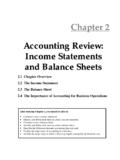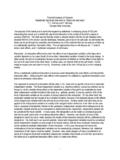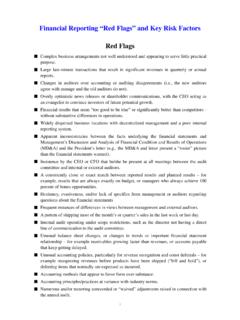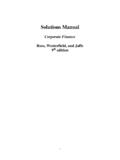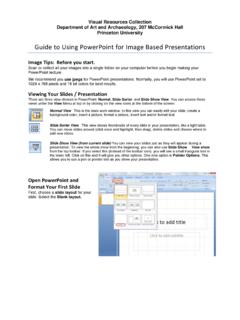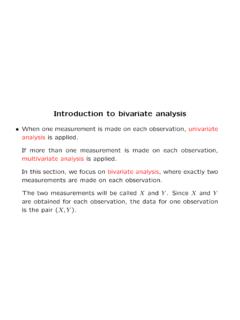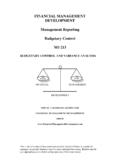Transcription of Chapter 3 Descriptive Statistics: Numerical Measures
1 11 SlideChapter 3 Descriptive statistics : Numerical Measures2 SlideLearning objectives1. Single variable Part I (Basic) How to calculate and use the Measures of How to calculate and use the Measures of variability2. Single variable Part II (Application) Understand what the Measures of location ( , mean,median, mode) tell us about distribution shape -Discuss its use in manipulating simulated How to detect outliers using z-score and empirical How to use Box plot to explore data How to calculate weighted mean How to calculate mean and variance for grouped data3.
2 Two How to calculate and use the Measures of association-Covariance, Correlation 1. Numerical Measures Part InNumerical measuresnMeasures of Location Mean, median, mode, percentiles, quartilesnMeasures of Variability Range, interquartilerange, variance, standard deviation, coefficient of variation4 SlideNumerical MeasuresIf the Measures are computedfor data from a sample,they are called sample the Measures are computedfor data from a population,they are called population sample statistic is referred toas the point estimatorof thecorresponding population meanof a data set is the average of all the data sample mean is the point estimator of the population mean.
3 XxNumber ofobservationsin the sampleSum of the valuesof the nobservationsixxn= ixxn= Number ofobservations inthe populationSum of the valuesof the NobservationsixN = ixN = Mean Median Mode Percentile Quartile6 SlideMediannThe medianof a data set is the value in the middlewhen the data items are arranged in ascending order. For odd number of observations: the median is the middle value For even number of observations: the median is the average of the middle two a data set has extreme values, the medianis the preferred measure of central location.
4 Often used in annual income and property value data Mean Median Mode Percentile Quartile47 SlideModenThe modeof a data set is the value that occurs withthe greatest greatest frequency can occur at two ormoredifferent values. If the data have exactly two modes, the data arebimodal. If the data have more than two modes, the data aremultimodal. Mean Median Mode Percentile Quartile8 SlideExamplenQ4 (p. 84)Compute the mean, median, and mode of the following sample:53, 55, 70, 58, 64, 57, 53, 69, 57, 68, 53 Mean = Median = 57 Mode = 53nWhat is the median, if 59 is addedto the data?
5 Median = = (57+58)/2 Mean Median Mode Percentile Quartile59 SlidePercentilesnA percentile provides information about how thedata are spread over the interval from the smallestvalue to the largest value. Admission test scores for colleges and universitiesare frequently reported in terms of pth percentileof a data set is a value such that at least ppercent of the items take on this value or less and at least (100 -p) percent of the items take on this value or more. Mean Median Mode Percentile Quartile10 SlidePercentilesArrange the data in ascending index i, the position of the (p/100)nIf iis not an integer, round up.
6 The pthpercentileis the value in the iis an integer, the pthpercentile is the averageof the values in positionsi and i+1. Mean Median Mode Percentile Quartile611 SlideQuartilesnQuartiles are specific Quartile = 25th PercentilenSecond Quartile = 50th Percentile = MediannThird Quartile = 75th Percentile Mean Median Mode Percentile Quartile12 SlideExample: Percentiles and QuartilesnQ4 (p. 84)Find 25thand 75thpercentiles from the sample below:53, 55, 70, 58, 64, 57, 53, 69, 57, 68, 53 25thpercentile = First quartile = 53 75thpercentile = Third quartile = 68 Mean Median Mode Percentile Quartile713 SlideMeasures of VariabilitynIt is often desirable to consider Measures of variability(dispersion), as well as Measures of location.
7 For example, in choosing supplier A or supplier B wemight consider not only the average delivery time foreach, but also the variability in delivery time for DeviationnCoefficient of Variation14 SlideRangenThe rangeof a data set is the difference between thelargest and smallest data is the simplest measureof is very sensitiveto the smallest and largest of the sample:53, 55, 70, 58, 64, 57, 53, 69, 57, 68, 53= 70 53 = 17 Range IQR Variance St. Deviation Coefficient of variation815 SlideInterquartile Range(IQR)nThe interquartilerangeof a data set is the differencebetween the third quartile and the first is the range for the middle 50%of the overcomes the sensitivity to extreme data of the sample:53, 55, 70, 58, 64, 57, 53, 69, 57, 68, 53= 68 53 = 15 Range IQR Variance St.
8 Deviation Coefficient of variation16 SlideThe varianceis a measure of variability that utilizesall the variance is computed as follows:The variance is the average of the squareddifferencesbetween each data value and the asamplefor apopulation 22= ()xNi 22= ()xNisxixn221= ()sxixn221= () Range IQR Variance St. Deviation Coefficient of variation917 SlideStandard DeviationThe standard deviationof a data set is the positivesquare root of the is measured in the same units as the data, makingit more easily interpreted than the standard deviation is computed as follows:for asamplefor apopulationss=2ss=2 =2 =2 Range IQR Variance St.
9 Deviation Coefficient of variation18 SlideThe coefficient of variation is computed as follows:Coefficient of Variation100%sx 100%sx The coefficient of variationindicates how large thestandard deviation is in relation to the asamplefor apopulation100% 100% Range IQR Variance St. Deviation Coefficient of variation1019 Slide = = = = == 22() == 22() standarddeviation isabout 11% ofof the mean nVariancenStandard DeviationnCoefficient of VariationExample: Variance, Standard Deviation,And Coefficient of VariationConsider the same data set:53, 55, 70, 58, 64, 57, 53, 69, 57, 68, 53 Range IQR Variance St.
10 Deviation Coefficient of 2. Numerical measure Part II nMeasures of Distribution ShapenDetecting Outliers z-score, empirical rule nExploratory Data AnalysisnThe Weighted Mean and Working with Grouped Data1121 SlideDistribution ShapenSymmetric (not skewed) Skewnessis zero. Mean and median are 2. Shape z-score Empirical Rule Exploratory Weighted mean Grouped data22 SlideDistribution ShapenModerately Skewed Left Skewnessis negative. Mean will usually be less than the 2. Shape z-score Empirical Rule Exploratory Weighted mean Grouped data1223 SlideDistribution ShapenModerately Skewed Right Skewnessis positive.

